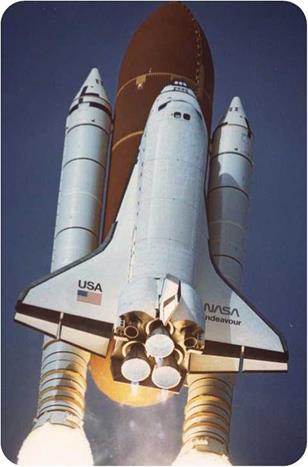The Engine and Fuel
The force produced by a rocket engine is called thrust. The upward force of thrust must be greater than the downward force of gravity if a rocket is to take off. One measure of an engine’s power and efficiency is its thrust-to-weight ratio. Rockets have the highest thrust-to – weight ratios of all engines.
Most rockets work by means of chemical reactions, combining two chemicals, or propellants: a fuel and an oxidizer. The oxidizer, consisting of oxygen or a
О A rocket must produce huge upward thrust to get into space. It does this by producing a high – pressure jet of hot gases.
chemical containing oxygen, is needed to burn the fuel. Burning produces hot gases that expand rapidly and rush out of the engine nozzle at high speed. According to Newton’s third law of motion, the gas jet pushes against the rocket, and the rocket pushes back against the gas jet with the same force. The result is that the rocket is thrust in one direction as the gas flies in the opposite direction.
Other types of rockets produce thrust from a high-pressure jet of water, air, steam, or another gas. Ion engines produce thrust by accelerating electrically charged gas particles.
|
|
One way to make a rocket accelerate faster, go farther, or carry a heavier payload is to make it lighter. For this reason, large rockets usually are built as a series of rockets standing on top of each other. The individual rockets are called stages. When each stage uses up its fuel, it falls away and the next stage fires. This enables the rocket to get rid of unnecessary weight that would slow it down.











